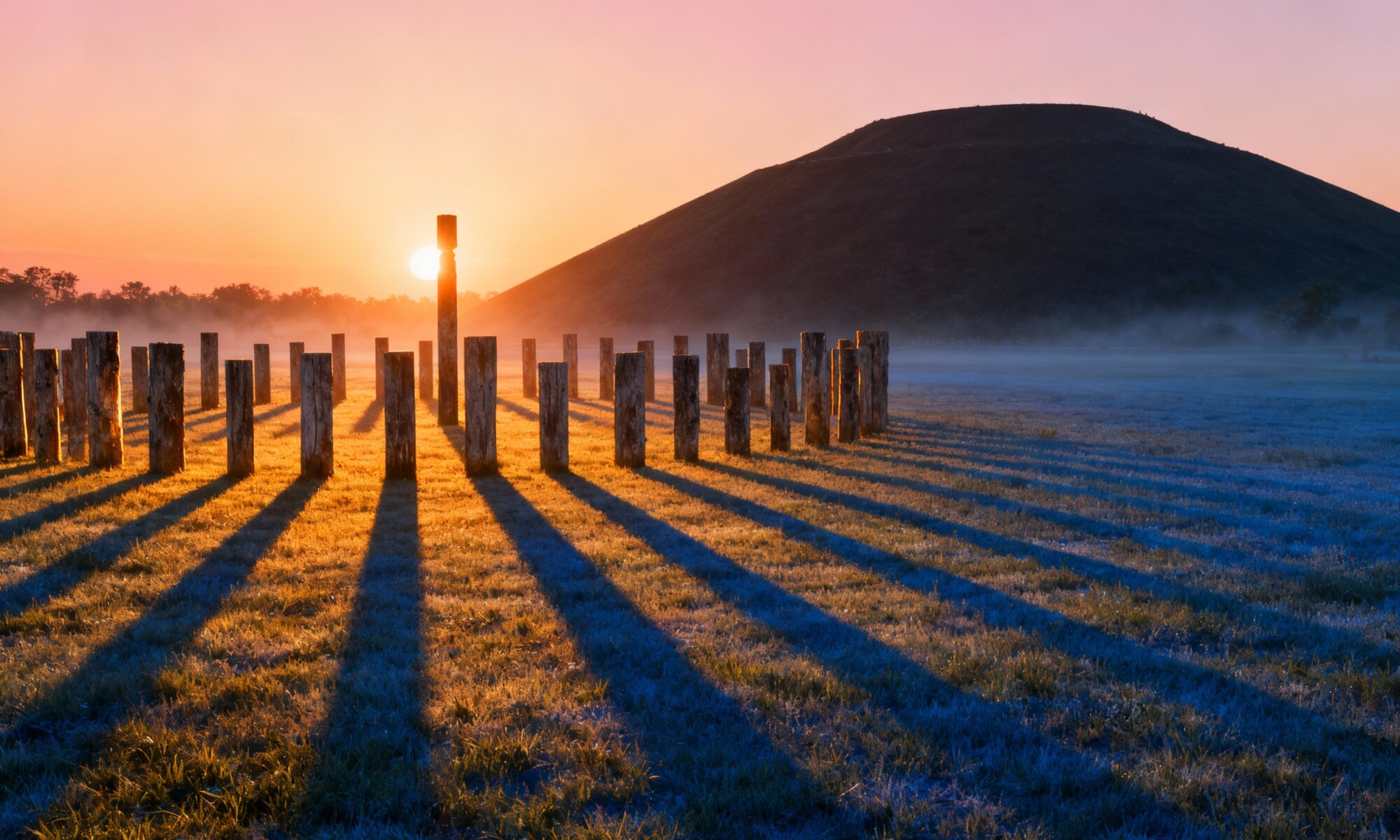Far from a simple stockade, these carefully placed timbers formed a sophisticated astronomical observatory. This massive solar calendar was a testament to the scientific and spiritual ingenuity of a civilization that left behind no written language, forcing us to decipher their story from the earth, the stars, and the silent markers they left behind.
The Discovery of a Sacred Circle
For decades, the true nature of Cahokia’s timber circles remained hidden. The posts themselves had long since rotted away, leaving only subtle stains in the soil. It wasn’t until the 1960s, during salvage archaeology ahead of highway construction, that Dr. Warren Wittry uncovered a series of post pits arranged in distinct, perfect arcs. Initially mistaken for houses or defensive walls, Wittry noticed a recurring pattern and had a “eureka” moment: these weren’t random placements; they were part of a massive circle.
Further excavation revealed that there wasn’t just one Woodhenge, but a series of at least five, built and rebuilt between approximately 900 and 1100 CE. Each successive circle was larger and used more posts than the last. The most famous and complete of these is Woodhenge III, which:
- Was constructed around 1000 CE.
- Measured about 410 feet (125 meters) in diameter.
- Contained 48 massive red cedar posts, each about 15-20 feet tall and spaced with remarkable precision.
Today, a reconstruction of Woodhenge III stands at the Cahokia Mounds State Historic Site, allowing visitors to stand within the circle and witness the same celestial alignments that guided the Mississippian people a millennium ago.
A Clockwork Cosmos
The primary purpose of Woodhenge was to function as a large-scale solar calendar. From a specific viewing point within the circle, a priest or sky-watcher could track the sun’s journey across the horizon throughout the year. This allowed them to pinpoint not just the changing seasons but the most important days of the solar cycle.
The system worked through a series of crucial alignments:
- The Equinoxes: During the spring and fall equinoxes, the sun rises due east. The central observation post of Woodhenge III was deliberately placed just east of the circle’s geometric center. From this post, an observer would see the sun rise directly over a post on the eastern edge of the circle, marking the two days of the year when day and night are of equal length.
- The Winter Solstice: This was perhaps the most dramatic alignment. From the same observation post, an observer would watch the sun rise on the shortest day of the year. The rising sun would appear perfectly aligned with the southeastern edge of the great Monks Mound in the distance, the political and religious center of the city. Some archaeologists believe the sun may have even risen directly over another, smaller mound known as the “Rattlesnake Mound”, further emphasizing the sacred connection between the sky, the calendar, and the city’s man-made landscape.
- The Summer Solstice: On the longest day of the year, the sun would rise at its northernmost point on the horizon, aligning perfectly with another dedicated post in the circle.
These posts weren’t just markers; they were the hands of a giant celestial clock. By tracking the sun’s position against these timbers, the priests of Cahokia could accurately predict these key dates. This knowledge was power.
More Than Just a Calendar
While tracking time was its primary function, the significance of Woodhenge extended far beyond simple calendrics. It was deeply woven into the social and spiritual fabric of Cahokian life.
Agricultural and Social Order
For an agricultural society dependent on maize, knowing when to plant and when to harvest was a matter of survival. The calendar provided the framework for the entire farming year. The ability of the city’s elite to “predict” the solstices and equinoxes would have reinforced their authority, portraying them as intermediaries between the people and the powerful forces of the sun and cosmos. The calendar dictated the timing of major community festivals, ceremonies, and feasts that would have brought together the city’s vast population.
A Ceremonial Space
The circle itself was almost certainly a sacred, ritual space. The act of erecting the massive posts, each weighing up to a ton, was a communal effort. The space within the circle, separated from the ordinary world, was likely used for important ceremonies celebrating the changing seasons. The alignment with Monks Mound on the winter solstice symbolically linked the temporal power of the city’s ruler with the cosmic power of the sun, creating a powerful statement of divine right and order.
Symbolism of the Cosmos
The very shape of Woodhenge was symbolic. In many Native American belief systems, the circle represents the world or the cosmos. The four cardinal directions carry deep meaning, and the movement of the sun is a sacred narrative. Woodhenge was a physical manifestation of this worldview—a microcosm of the universe built on earth. It was a place where the earthly realm and the celestial realm met.
The Enduring Legacy of Woodhenge
Long after the last post rotted away and the city of Cahokia was abandoned, the imprint of Woodhenge remained in the soil—a quiet reminder of a society that possessed a profound understanding of the sky. It stands as a powerful counter-narrative to the outdated idea of pre-Columbian North America as a simple or static world.
The Cahokia Woodhenge reveals a civilization with sophisticated knowledge of mathematics, engineering, and astronomy. It was a tool of science, an instrument of power, and a cathedral to the sun. When you stand in the reconstructed circle today, looking out at the horizon, you are sharing a view with the ancient people who sought to find their place in the cosmos and bring its sacred, predictable rhythm down to earth.
